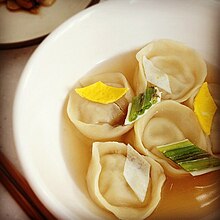Mandu-guk
 | |
| Alternative names | Dumpling soup |
|---|---|
| Type | Guk |
| Place of origin | Korea |
| Main ingredients | Mandu |
| 88 kcal (368 kJ)[1] | |
| Korean name | |
| Hangul | 만두국 |
|---|---|
| Hanja | 饅頭- |
| Revised Romanization | mandu(-t)-guk |
| McCune–Reischauer | mandu(-t)-kuk |
| IPA | [man.du(t̚).k͈uk̚] |
Mandu-guk[2] (만두국, 饅頭-) or dumpling soup[2] is a variety of Korean soup (guk) made by boiling mandu (dumplings) in a beef broth or anchovy broth mixed with beaten egg.[3]
History[]
According to the 14th century records of Goryeosa (고려사), mandu had already been introduced via Central Asia during the Goryeo era. Mandu was called sanghwa (쌍화) or gyoja (교자) until the mid-Joseon Dynasty and became a local specialty of the Pyongan and Hamgyong regions, as both wheat and buckwheat — the main ingredients for flour — were mainly cultivated in the north.[4]
Mandu was made and cooked in various ways, including manduguk. In the Korean royal court, the dish was called byeongsi (병시) while in Eumsik dimibang, a Joseon Dynasty cookbook, it was called "seokryutang" (석류탕). The exact era when manduguk got its modern name is unknown.[5]
Preparation and serving[]

Dumplings are made by rolling out thin circles of dough, creating a half-moon shape and filling them with a mixture of minced meat, vegetables, tofu and sometimes kimchi. The dumplings are then boiled in a broth traditionally made by boiling anchovies, shitake mushroom stems and onions.
Some variations make the broth from beef stock. The addition of tteok which is a cylindrical rice cake is common as well, changing the dish's name into tteok-mandu-guk.[2][6]
See also[]
References[]
- ^ "mandu-guk" 만두국. Korean Food Foundation (in Korean). Retrieved 16 May 2017.
- ^ a b c (in Korean) "주요 한식명(200개) 로마자 표기 및 번역(영, 중, 일) 표준안" [Standardized Romanizations and Translations (English, Chinese, and Japanese) of (200) Major Korean Dishes] (PDF). National Institute of Korean Language. 2014-07-30. Retrieved 2017-02-16.
- 주요 한식명 로마자 표기 및 표준 번역 확정안 공지. National Institute of Korean Language (Press release) (in Korean). 2014-05-02.
- ^ (in Korean) Manduguk at Doosan Encyclopedia
- ^ (in Korean) Mandu at Encyclopedia of Korean Culture
- ^ (in Korean) Manduguk Archived 2011-06-10 at the Wayback Machine at Encyclopedia of Korean Culture
- ^ (in Korean) Recipe for tteok manduguk, Naver kitchen
External links[]
- Winter foods at Korea Tourism Organization official site
- Korean soups, Life in Korea
- Recipe for manduguk
- Dumplings
- Korean soups and stews
- Anchovy dishes